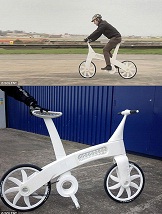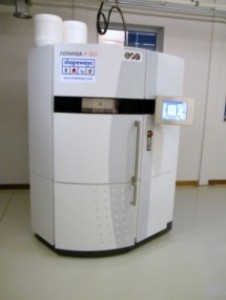I’m sure you’ve already heard of 3D printing. Most people love to imagine a future where we can replicate whatever we want, like Star Trek. But that’s just wishful thinking for science fiction writers, right?
Welcome to the future! 3D printing is now making waves across the globe!
Looking to buy a 3D printer? Head over to the 3D printer review page!
Some 3D printing technologies have already been used by manufacturers for a long time. In fact, the first additive manufacturing process (this is another name for 3D printing) was patented in 1979! But it wasn’t until the mid-1980s to 1990s that 3D printing became commercialized.
Even then, 3D printing technologies weren’t available to the general public. The advantage they provided for rapid production of prototypes and concept models was quickly noted by commercial firms, however. 3D printing technology began to progress, gradually becoming cheaper and more available. These days you can actually get a fully-functional 3D printer for the price of a higher end Kindle. You can even get a 3D printer at a department store now! Of course, there’s a catch. You have to factor in raw material costs, and there are limitations on what can be printed. Obviously a small, cheap printer can’t make you a real car. You get what you pay for!
Still, even a tiny printer gives you a lot of possibilities. Businesses all over the world recognize the potential of 3D printing. In 2010, the industry grew by astonishing 24.1%, and it is predicted that by 2020 global 3D printing industry will reach $5.2 billion – $3.5 billion more than today’s $1.7 billion.
And it’s not just quantitative growth. 3D printing technologies are constantly evolving, and more and more applications for them are found every year. Today, engineers and scientists are taking 3D printing in unexpected, fantastic directions.
Did you know that you can print new skin for use on burns? And how about printing a whole new kidney? It’s not some distant, unrealistic dream, either. Commercial bioprinters that can be used to make tissues are already on the market. Check out this collection of 3D printing videos for some more amazing things that people are printing!
3D printing technology has improved a lot since the eighties. Today, there is a wide variety of technologies that let you do almost anything – from printing chocolate to making titanium parts so strong and robust they can be used in aerospace industry.
All 3D printing technologies depend on six core processes. These processes are: photocuring (represented by SLA, DLP and MJM), sintering (SLS and DMLS), melting (EBM and DMP), lamination (LOM), extrusion (FDM and PJP) and, finally, jetting (MJM,SCP and DMP). And, of course, 3D printing technologies that share a core process have a lot of other similarities as well.
Photocuring is sometimes combined with jetting. Photocuring-based printers work by curing a light-sensitive material – a photopolymer – either with ultra-violet rays or white light from lasers or lamps. Even though photocuring is limited to only one class of materials – photopolymers – it has a wide array of other options, such as accuracy, resolution of details, speed, cost, size of the product, material variation (inside the photopolymer class, of course). It also offers good surface finish. The chief drawbacks of photocuring are that product stability and dimensions suffer over time, and a secondary process is often needed. Also, the properties of photopolymers differ significantly from production plastic properties.
Best suited for: concept models, patterns and prototypes.
Associated 3D printing technology: Stereolithography,DLP, MJM
Sintering-based 3D printers heat materials so they fuse. Typically a laser “draws” a cross-section of the printed part on a thin layer of powder, sintering it. Another layer of powder is spread on top of it, another cross-section is sintered by a laser, and so on, until the part is finished. Sintering-based technologies use thermoplastics and metal alloys, which lets you print functional, robust parts. Accuracy, however, is only average, and a skilled operator is usually required.
Best suited for: functional prototypes, low-volume production of complex components, investment casting.
Associated 3D printing technology: Selective Laser Sintering, DMLS.
Melting 3D printing involves, well, melting of a metal alloy to create cross-sections of the printed model. Usually an electron beam or laser is used to melt the metal, however, sometimes metal powder is first melted and then deposited to print a model. This process only uses metal alloys, however, it lets you create parts that match or even exceed traditionally fabricated parts. Furthermore, systems that deposit molten metal may be used to repair an existing part. EBM also offers very good material properties of the printed part, as well as incredible accuracy. However, melting-based 3D printers usually require a skilled operator, and secondary machining operations must be needed.
Best suited for: functional prototypes, low-volume production of complex components and tooling components.
Associated 3D printing technology: EBM, DMP
Lamination is a 3D printing process which involves cutting sheets of materials into cross-sections of printed model, and bonding these cross-sections together, usually with adhesives. Lamination-based 3D printers use simple paper as raw material. They offer fairly cheap, fast (for large models) and simple production. However, they aren’t suited for printing models with fine details, and since the material used is paper – well, don’t expect the printed part to live long if it’s left uncoated. Lamination-based 3D printers can also waste a lot of material.
Best suited for: wood-like models and concept models.
Associated 3D printing technology: Laminated Object Manufacturing
Extrusion-based 3D printers work by extruding a continuous bead of material via pressure and heat. They use a variety of non-metal meltable materials, chiefly thermoplastics, and offer strong and functional parts while being easy to use. Basic models are quite cheap, as are basic materials. However, the process isn’t suited for creation of fine parts, and surface finish of printed models isn’t very good.
Best suited for: functional and durable models, production parts and manufacturing tools.
Associated 3D printing technology: Fused Deposition Modeling, Plastic Jet Printing, Thermoplastic Extrusion
Jetting 3D printers are a lot like standard inkjet printers people are used to: an inkjet-like head deposits drops of part material on a platform or drops of a binder on a powder bed. The raw materials vary from ceramics, sand, metal and plastic to thermoplastic and wax. This is actually one of the advantages – jetting 3D printers offer a wide variety of materials. Other advantages are the smoothness of the printed models and the higher degree of accuracy of this method compared to others. Also, when using a binder, large parts can be created. The main drawback is that if a binder is used, resolution and smoothness suffer, and if material is deposited, material properties of the finished product aren’t very good.
Best suited for: large objects, smooth models with lots of fine detail, fast and cheap models.
Associated 3D printing technology: MJM,SCP, DMP



Freaking amazing stuff. Just out of curiosity, how much would printing something like the bike cost? I’ve seen a few 3d printers that aren’t too expensive initially, but if the cost of “ink” is pretty low, I’m definitely getting on this.
Well, the cost is definitely coming down, but I expect you could still buy a dozen mass-produced bikes for the cost of printing one. The benefit is when you need something custom. You can customize anything with your own 3D printer.
I am looking for 3d printer able of printing detailed oil painting. by detail I mean bulges,color reliefs,lines and roughness that real oil painting has. I am not worried by any price range,I am just wondering is such printer made and is it possible to by one.
A detailed oil painting? That seems like a tall order! I have feeling that 3D printers will never be able to successfully emulate a Renaissance masterpiece. Perhaps that’s a good thing?
What would be the best type of printer for production runs of 5-10 parts a day of a complex consumer product of 60 cubic cm, in opaque black, that must withstand outdoor use and be under $20 per part for material and maintenance? Finish is not too important.
For a printer of that type, you might want to look at the larger business level printers. They cost in excess of $20,000, although prices are coming down on these as well. Check out the Dimension series of printers from Stratasys. The Dimension 1200es is around $35,000.